![]()
![]()
![]()
Use LEFT and RIGHT arrow keys to navigate between flashcards;
Use UP and DOWN arrow keys to flip the card;
H to show hint;
A reads text to speech;
67 Cards in this Set
- Front
- Back
|
Define atmosphere? |
Layer of gas surrounding the Earth |
|
|
Define hydrosphere? |
Made up of water and dissolved particles |
|
|
Define lithosphere? |
Outer layer of Earth... Made up of crust and the part of mantle just below... Consists of mixture of minerals... And silicon, oxygen and aluminium |
|
|
What do O2, N2, CO2 and Ar have in common? |
They are gases at 20 C |
|
|
Why are O2, N2, CO2 and Ar gases at 20 C? |
They have low boiling points(negative) |
|
|
How can the low boiling points of the atmospheric elements be explained? |
By the structure of the molecules: Gases have small molecules... With weak forces of attraction between them... So only small amounts of energy are needed to break these forces |
|
|
What do pure molecular compounds not do? |
Conduct electricity |
|
|
Why don't pure molecular compounds conduct electricity? |
Their molecules aren't charged |
|
|
What are the atoms within molecules connected by? |
Covalent bonds |
|
|
What are in covalent bonds? |
Strong bond between non-metal atoms Electrons are shared between the atoms A strong, electrostatic attraction is created between each positive nucleus... And the shared pair of negative electrons... To achieve a full outer shell of electrons |
|
|
What is the covalent bond for H2? |
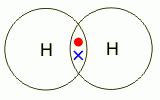
H-H |
|
|
What is the covalent bond of Cl2? |

Cl-Cl |
|
|
What is the covalent bond of O2? |
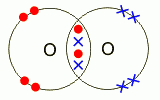
O double bond O |
|
|
What do dot and cross diagrams show? |
Shared pairs of electrons in the outer shell |
|
|
What is the aim of a covalent bond? |
Each atom needs to be in contact with eight electrons in its outer shell so that it is stable |
|
|
How do you work out how many pairs of electrons are shared? |
8 - Group number |
|
|
H20 covalent bond? |
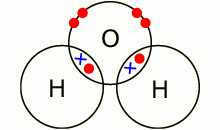
H-O-H |
|
|
HCl covalent bond? |
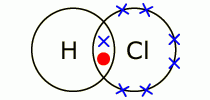
H-Cl |
|
|
NH3 covalent bond? |
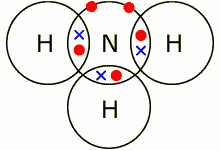
|
|
|
CH4 covalent bond? |
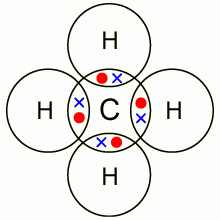
|
|
|
Define diamond? |
A form of pure carbon... In which each carbon atom is covalently bonded to 4 other carbon atoms... To give a very hard substance |
|
|
Define graphite? |
A form of pure carbon... In which each carbon atom is covalently bonded to 3 other carbon atoms... To create a structure made of sheets that can slide over each other... Therefore it is soft... And conduct electricity.... Because spare electrons can move between the layers of atoms |
|
|
Where is carbon found? |
In the lithosphere |
|
|
What do diamond and graphite have in common? |
High melting points Insoluble in water |
|
|
Structure of diamond diagram? |
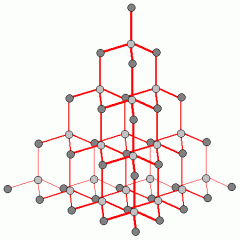
|
|
|
CO2 covalent bond? |

|
|
|
Structure of graphite? |
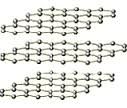
|
|
|
What is silicon and oxygen present as in the lithosphere? |
Silicon dioxide SiO2 |
|
|
How is SiO2 similar to diamond? |
Forms a giant covalent structure... So it is hard... Has a high melting point... Is an electrical insulator... And is insoluble in water |
|
|
Why is seawater in the hydrosphere salty? |
It contains dissolved ionic compounds called salts |
|
|
Describe sodium chloride's structure? |
Positive sodium ions and negative chloride ions are electrostatically attracted to each other... To form a giant 3D crystal lattice... With high melting and boiling points |
|
|
What is the formulae for sodium chloride? |
NaCl |
|
|
What is the formulae for magnesium sulfate? |
MgSO4 |
|
|
What is the charge of SO4? |
2- |
|
|
What is the charge for OH? |
1- |
|
|
What is the formula for potassium chloride? |
K+ Cl- KCl |
|
|
Potassium bromide formula? |
K+ Br- KBr |
|
|
What are the properties of ionic compounds? |
High melting point Don't conduct electricity when solid Conduct electricity when molten/dissolved in water |
|
|
Why do ionic compounds have a high melting/boiling point? |
High melting points/ boiling points... Because ions are held together by strong forces of attraction in a lattice. |
|
|
Why do ionic compounds not conduct electricity when solid? |
Ions are fixed in place and cannot move |
|
|
Why can ionic compounds conduct electricity when molten/dissolved? |
Ions are free to move |
|
|
Why do ionic compounds dissolve in water? |
Many water molecules are polar... Meaning they have a positive end and a negative end |
|
|
Describe the dissolving of ionic compounds in water? |
1) A water molecule is attracted to an ion in the crystal lattice 2) An ion breaks away from the lattice 3) The ion freely moves through the water |
|
|
How can precipitation be used to test for ions? |
Oceans contain calcium ions- Ca2+... Which combine with carbonate ions- CO3 2-... This forms insoluble calcium carbonate CaCO3- AKA limestone These type of reactions where insoluble solids are formed can be used to detect ions in aqueous solutions... By interpreting solubility |
|
|
Define precipitate? |
The solid formed in a reaction between two liquids |
|
|
How can positive metal ions be identified in solution? |
By adding sodium hydroxide solution- NaOH Then observing colour of the precipitate |
|
|
What is the charge of hydroxide OH? |
- |
|
|
What is the symbol equation of copper + hydroxide ---> copper hydroxide? |
Cu2+(aq) + 2OH-(aq)---> Cu(OH)2(s) |
|
|
Why can many negative(non-metal) ions be identified in solution?
|
They will react with other aqueous ions to produce insoluble precipitate |
|
|
Define ore? |
Rocks which contain naturally occurring minerals from which a metal is extracted |
|
|
What does the method of extraction depend on? |
Reactivity of metal |
|
|
Which metals are less reactive than carbon? |
Zinc Iron Copper |
|
|
How can metals, which are less reactive than carbon, be extracted from their oxides? |
By heating with carbon |
|
|
What is the process of the extraction of a metal oxide? |
The metal oxide is reduced as it loses oxygen The carbon is oxidised as it gains oxygen |
|
|
Zinc oxide word equation? |
Zinc oxide + carbon---> Zinc + carbon dioxide |
|
|
Define relative formula mass? |
The sum of the atomic masses of all atoms in a molecule |
|
|
Define electrolysis? |
An electric current causes the breaking down of an electrolyte |
|
|
Define electrolyte? |
The molten or aqueous solution of an ionic compound used in electrolysis |
|
|
Define current? |
The rate of flow of an electrical charge measured in A |
|
|
Why is electrolysis done? |
To extract reactive metals from their ores... Because they are too reactive to be extracted by heating with carbon |
|
|
What happens when an ionic compound melts? |
Electrostatic forces between the charged ions in the crystal lattice are broken down and the ions are free to move |
|
|
What happens when a direct current is passed through a molten ionic compound? |
Positively charged ions are attracted towards the negative electrode Negatively charged ions are attracted to the positive electrode |
|
|
Describe the electrolysis of lead bromide? |
Positively charged lead ions are attracted to the negative electrode... Which forms lead(metal) Negatively charged bromide ions are attracted to the positive electrode... Forming bromine(non-metal) |
|
|
What happens when ions get to the oppositely charged electrode? |
They are discharged- they lose their charge |
|
|
Half equations for lead bromide? |
Br- --->Br2 + 2e- Pb2+ +2e- ---> Pb |
|
|
What happens to aluminium at the negative electrode? w/ half equation |
Aluminium ions gain electrons to become neutral atoms: Reduction Al3+ + 3e- ---------------> Al |
|
|
What happens to oxygen ions at the positive electrode? w/ half equation |
Oxygen ions lose electrons to become neutral atoms: Oxidation 2O2- -4e- ---------------> O2 |

